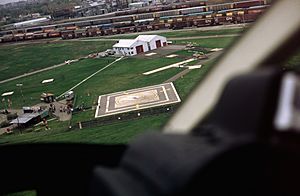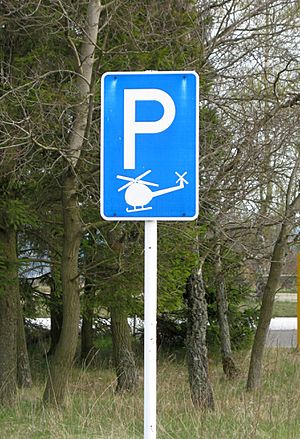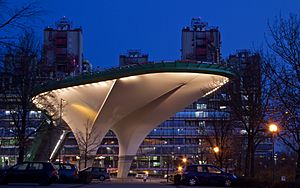Heliport facts for kids
A heliport is a special, small airport made just for helicopters. Think of it as a parking lot and mini-station for helicopters! Heliports usually have one or more helipads, which are the spots where helicopters land and take off.
They might also have a few other things. This can include fuel, lights for night flying, a windsock to show wind direction, or even hangars to store helicopters. In bigger cities, some heliports even have customs facilities. This means people can arrive from other countries by helicopter.
Early on, many people thought heliports would be very popular in cities. However, they haven't become as common in urban areas. This is mainly because of the loud noise that helicopters make when they fly around.
Contents
Why Do We Need Heliports?
In a big city, a heliport helps people travel quickly. They can move fast within the city or to areas outside of it. Heliports can often be built much closer to a town or city center than a regular airport. This is because helicopters don't need long runways like airplanes.
Flying by helicopter can be much faster than driving. For example, the Downtown Manhattan Heliport in New York City offers flights to John F. Kennedy International Airport. It's also used to move important people and goods quickly. They can even go to places as far away as Maryland.
Some very tall buildings, called skyscrapers, have helipads or heliports on their roofs. These are used by business leaders or important clients. The U.S. Bank Tower in Los Angeles is one example of a building with a rooftop helipad.
Police departments also use heliports. They serve as a home base for police helicopters. Larger police forces might have their own special heliport, like the LAPD Hooper Heliport.
Heliports are very common at hospitals. They are super important for MEDEVAC flights. These are flights that quickly move injured or sick people. They also help with air ambulance transfers. Patients can be taken to special trauma units. Or, they can be brought from far-off places that don't have big hospitals. In cities, these hospital heliports are usually on the roof.
How Heliports Are Marked
Heliports are not set up in a certain direction. They also don't have numbers like airplane runways do. In some cities in the United States, it's common to paint a number on the helipad. This number shows the heaviest weight a helicopter can be when it lands. It's usually in thousands of pounds. So, if you see a 12 in a circle, it means a helicopter weighing up to 12,000 pounds can land there.
Some hospital heliports in Canada have a cross painted on them. Others have the letter "H" in the middle. These symbols help pilots know it's a hospital landing spot.
Lights at a Heliport
Heliport lighting helps pilots land safely, especially at night. It usually includes a circle or square of lights around the main landing spot. This area is called the TLOF, which stands for "touchdown and lift-off area." There's also another set of lights around the larger landing area. This is called the FATO, or "final approach and takeoff area." The FATO includes the TLOF. These lights can be flat with the ground or raised up.
The International Civil Aviation Organization and Federal Aviation Administration now suggest these lights should be green. Yellow (or amber) used to be the standard color. You might still see yellow lights in many places. The color can change depending on who owns the heliport.
These lights used to be incandescent (like old light bulbs). Now, more and more of them are light-emitting diodes (LEDs). LEDs are brighter and use less energy. They also have controls to change how bright they are. Besides these lights, a lighted wind cone is always needed. This shows pilots the wind direction.
Sometimes, at ground-based heliports, there's a row of lead-in lights. These lights show the best direction for a helicopter to approach. Pilots can often control the heliport lights themselves using their radio. This is done through a special system on the ground.
Related pages
Images for kids
See also
 In Spanish: Helipuerto para niños
In Spanish: Helipuerto para niños






